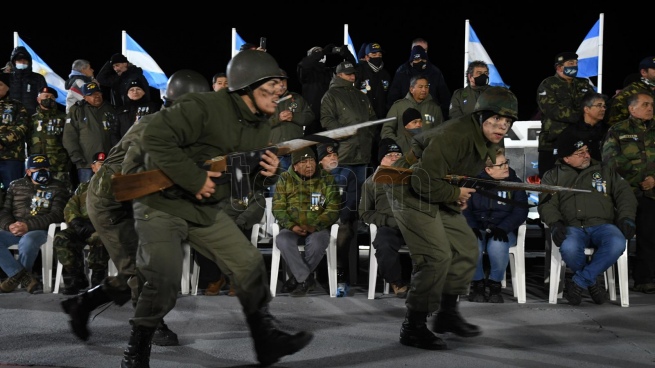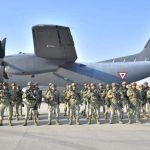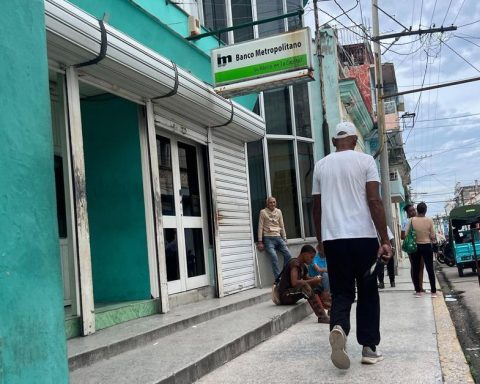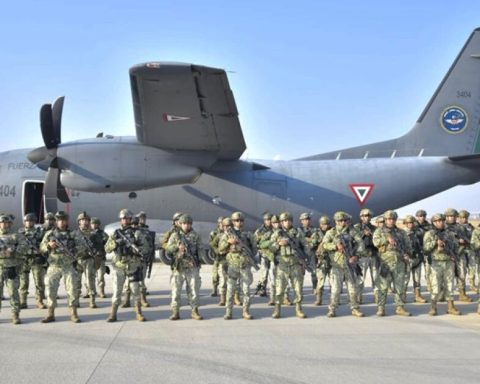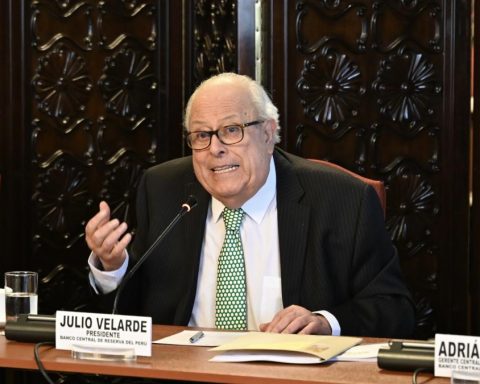With temperatures below zero, a crowd gathered on Friday night in the Fuegian city of Rio Grande to be part of the traditional and emotional vigil for Malvinaswhich was held again after two years of the pandemic, and this time with the framework of the 40 years of the war.
Despite the intense cold, a large demonstration gathered, from 20, at the Monument to the fallen to accompany ex-combatants and war veterans in the city of Fuegian and witness one more edition of the vigil, inaugurated by a small group of ex-combatants in 1995, when they began to share experiences around a 200-liter tank, almost 600 kilometers from the islands.

“We hope that when we are not here someone will raise the Malvinas flag, that someone will turn on the bin and tell our story, which is their story,” said Sergio, a member of the Rio Grande War Veterans Center, at the end of the vigil. Marroco, the only speaker who had the act in front of the shores of the Argentine Sea.
“We invite you to build an official history. Not for us, but for the generations to come. So that they understand why all this has the significance,” he added and ignited the applause of the thousands of those present.
On behalf of the national government, the Ministers of Defense, Jorge Taiana; Science, Technology and Innovation Daniel Filmus; and Health, Carla Vizzotti; and the secretary of Malvinas, Guillermo Carmona, among others. The national deputy Leandro Santoro was also present.

After a brief mass officiated at 8 pm by the local parish priest and the pilgrimage of dozens of torches in commemoration of the 649 fallen in the war, one of the most exciting first moments of the night arrived.
Before the eyes of children, young people and older adults, the Marine Infantry Battalion No. 5 (BIM5) carried out the simulation of the landing of “Operation Rosario”, a military tactical movement through which the Argentine de facto government briefly recovered the sovereignty of the islands, thus declaring war against the United Kingdom.
After the fall of two red flares on the sea, some 20 Navy soldiers arrived at the shore aboard an amphibious vehicle in the middle of the darkness and advanced among the spectators, all reported by the voiceover of Miguel Vázquez , a member of the Rio Grande War Veterans Center, who gave details of the landing over the loudspeaker.
Portrayed with special effects and artificial explosions, the Argentine soldiers exchanged fire with the British who defended a green wooden house -which represented the place where the British governor of the islands, Rex Hunt, was on that April 2, 1982-, and They raised the Argentine flag after the English surrender.

The day continued with the group of folkloric dances “Soles that leave a mark”, by Santiago Soto, who performed an emotional demonstration with male and female dancers dressed in soldier’s uniforms and carrying rifles.
Arriving at 12, the sound of sirens shook those present just as a plane passed over the heads of the thousands of people in front of the Monument to the Fallen.
Immediately afterwards, a minute of silence, the anthem of the Malvinas Argentinas and the Argentine national anthem sounded loud in all the throats.
“Time passed in these 40 years, but neither the feeling, nor the conviction, nor the emotion is reduced”Minister Taiana said once the act was over, adding: “I believe that there is solid and growing support from society. Today we are going to see it throughout the country.”
For her part, Minister VIzzotti also commented on her feelings after the vigil: “We have to value what we did not have for two very difficult years and that we now have, and be able to get together, meet and recognize the veterans, those who came back and those who stayed there.”
On the demalvinization process that veterans and ex-combatants suffered after the end of the war, he stated: “This is what happened from the State. It must be recognized and repaired.”

Meanwhile, Filmus recalled that “Argentina has been demanding that the United Kingdom once and for all sit down at the table in the terms established by United Nations resolution 2065” and remarked: “For us it is clear that colonialism has no place in the 21st century, the interests that the United Kingdom defends are economic, military and geopolitical interests”.
In his turn, the executive secretary of the Malvinas Museum, Juan Rattenbach, said: “For me, Malvinas is our history. It is the pride of our country and nation.”
“Including the Malvinas we are going to develop as a country and our economy is going to grow,” said the grandson of Benjamín Rattenbach, the lieutenant general who carried out a report -declassified in 2012- that called for very high penalties for high command for their responsibilities in conducting the war.

Also present at the vigil was the governor of Jujuy, Gerardo Morales, who maintained that the Malvinas cause “united the Argentine people” and added: “I hope it serves as one of the milestones that unites us on other issues as well.”
The deputy of Together for Change (JxC) Julio Cobos was also present: “Every year this is important, beyond 40 years, but today it has a special meaning. The figure becomes gigantic with all the heroes we had” , he expressed.
Among other authorities, the Chief of Staff of the Ministry of Defense, Héctor Mazzei; the Secretary of International Affairs, Francisco Cafiero; and the president of the Télam news agency, Bernarda Llorente.
In military representation were the head of the Joint Chiefs of Staff of the Armed Forces, Lieutenant General Juan Martin Paleo; the Chief of the General Staff of the Air Force, Brigadier General Xavier Isaac; and the Chief of the General Staff of the Navy, Admiral Julio Guardia.
After the deconcentration, some of those present were able to taste the malvinero locro distributed 50 meters from the place by members of the Private Oil and Gas Union.
-
Coverage for you and your family group in PAMI
-
If you need psychological assistance, call 139
-
For psychiatric emergencies call 138, option 7
- • More info at War Veterans Centers
